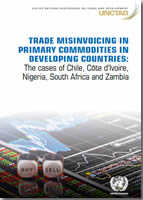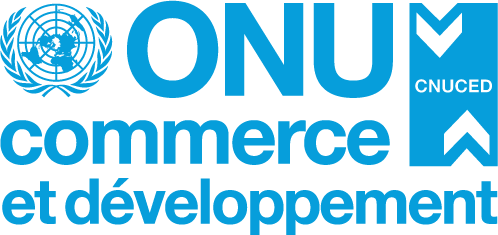
Trade in primary commodities is a key driver of growth in many developing countries. However, for the commodityled growth to be sustainable and more generally for globalization to be more inclusive, it is important to ensure that producing countries are able to capture their legitimate share of the gains from international trade in terms of foreign exchange earnings and fiscal revenue collected from customs and other trade levies. At the same time, features of the regulatory environment, notably tariffs, customs, export subsidies, exchange controls, coupled with imperfect monitoring and poor enforcement of regulations, may create incentives for trade misinvoicing by agents seeking to maximize profits and other gains such as access to foreign exchange out of control of the regulating authority, thus undermining developing countries’ gains from commodity trade.
Trade misinvoicing has been a long-standing concern in the economics profession since the seminal work by Jagdish Bhagwati in the 1960s (Bhagwati, 1964, 1967). This work in turn drew on an even older strand of literature concerned with the consistency of partner data on international trade dating back from the 19th century (see Ferraris (1885) as cited in Morgenstern (1963, Chap. IX)). Comparison of bilateral trade statistics is based on the simple principle proposed by Ferraris (1885) that the value of exports of a country A to a country B as reported by country A should agree with the value of country B’s imports from country A as reported by country B. Normal discrepancies should represent the cost of freight, insurance and duties. In practice, however, two possible scenarios may arise (Bhagwati, 1967). The first is the situation where comparison of partner data reveals discrepancies in the “perverse” direction; i.e., where the value of a country’s c.i.f. import is less than the value of the corresponding f.o.b. exports of its trading partner. Such ‘perverse’ discrepancies suggest either overinvoiced exports or underinvoiced imports or both (Bhagwati, 1967, p. 69). The second scenario is when there are “excessive normal” discrepancies, where the difference is in the right direction but exceeds reasonable values of the costs of freight, insurance and duties. These situations provide prima facie indication of either underinvoicing of exports or overinvoicing of imports. The literature on trade misinvoicing provides evidence on these potential scenarios through partner data comparisons. This study uses this well-established concept of trade misinvoicing and follows this long-standing line of inquiry with an application to the case of commodity dependent developing countries.
This study specifically aims to contribute to research and policy debates by providing empirical evidence on the magnitude of trade misinvoicing in the particular case of primary commodity exports from a sample comprising four resource-dependent developing countries (Chile, Côte d’Ivoire, Nigeria and Zambia) and a more diversified resource-rich middle-income country (South Africa). It covers a representative sample of products in the three main categories of primary commodities: oil and gas; minerals, ores and metals (copper, gold, iron ore, silver and platinum1); and agricultural commodities (cocoa). Two copper exporters (Chile and Zambia) are selected to compare and contrast patterns and trends of copper misinvoicing.
The work on trade misinvoicing has been based on publicly available data on international trade compiled from government sources by major international institutions such as the IMF and the United Nations Statistics Division.
The IMF’s Direction of Trade Statistics offers data that enable to estimate trade misinvoicing at the aggregate level, which has been integrated in the estimation of capital flight from developing countries dating back to the 1970s (Bhagwati et al., 1974). This line of inquiry gained momentum since the 1980s in the context of the debt crisis (Lessard and Williamson, 1987), and since then it has taken prominence in both the academic literature and the policy arena (see, among others, Ndikumana et al. (2015), Beja (2006); (Beja, 2007), Patnaik and Vasudevan (2000); more references are given in Section 2.1). The analysis of trade misinvoicing at the disaggregated level; i.e., at the sector and product levels, and by trading partner, has generated growing interest, which is motivated by two major factors. First is the presumption that some products may be more prone to trade misinvoicing than others based on their idiosyncratic characteristics. Second, there may be variations among trading partners with regard to transparency and enforcement of trade recording rules that may generate differences in trade misinvoicing across partners.
This study describes in detail the process of using UN Comtrade data to identify major products and leading partners that will be the focus of the analysis based on the established statistical methodology for estimation of export misinvoicing at the product and partner levels. In the case of Nigeria, which exports oil and gas while also relying on imported oil products, the study also investigates the extent of oil import misinvoicing.
The data show heavy concentration of exports both by product and by partner. With the exception of South Africa, the export baskets of the countries in this sample exhibit a heavy dependence on two to three primary commodities. These stylized facts illustrate the relevance and appropriateness of the sample of countries selected for this study.
The results from the analysis show substantial levels of trade misinvoicing in all five countries covered by the study, but the patterns vary substantially across countries, products and trading partners. Some interesting patterns and contrasts emerge. At the product level, while trade in copper exhibits large amounts of export overinvoicing in Chile, the results for Zambia show substantial export underinvoicing. In particular, while Zambia’s data shows that Switzerland is the top buyer of its copper (51 percent), no copper imports from Zambia appear in Switzerland’s trade data. The case of gold exports from South Africa is also strikingly peculiar. Imports of nonmonetary gold reported by trading partners vastly exceed exports recorded by South Africa. While non-monetary gold and monetary gold are reported separately in national trade statistics, the two series are inexplicably merged starting in 2011. Trade in iron ore from South Africa exhibits export underinvoicing. Exports of oil from Nigeria and silver and platinum from South Africa show mixed results - both underinvoicing and overinvoicing. At the partner level, the Netherlands also presents a peculiar case, where Nigerian oil registered as exported to the Netherlands cannot be traced in the Netherlands’ bilateral trade data. In contrast Germany’s trade of all products with all the countries in the sample exhibits export underinvoicing. The results generally show a close correlation between export concentration by destination and the extent of trade misinvoicing.
The next section provides a review of the literature on the main mechanisms and motivations of trade misinvoicing. Section 3 describes the method of compilation of the data and presents some stylized facts. Section 4 presents the methodology used for estimation of trade misinvoicing. The results by country, product and partner are presented in section 5. Section 6 concludes with a summary of the results and some policy recommendations.




